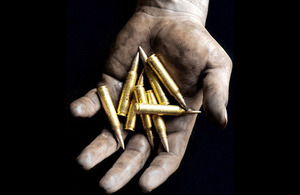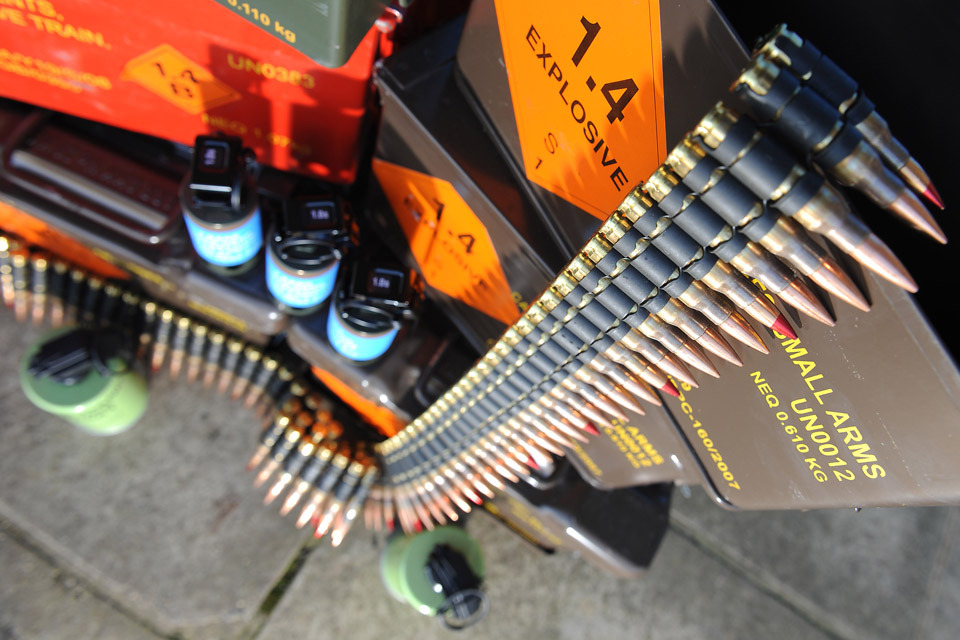Projectile management
Keeping MOD's shelves stocked with the right amount of bombs, bullets, grenades and explosives is a skilled balancing act.

5.56mm rounds being held in the hand prior to loading into a magazine (library image) [Picture: Petty Officer (Photographer) Sean Clee, Crown copyright]
It happens in every household. You get to the end of the week, and you are cursing yourself for buying all those yoghurts you haven’t eaten. And despite being determined to keep the housekeeping costs under control, yet again you are pitching out products past their sell by date. Yet for some reason you’re out of bread. Again.
Imagine then the housekeeping headaches for those charged with keeping MOD’s £40 billion inventory under control. Seven per cent of that mind-boggling amount resides in a single project team – Defence General Munitions (DGM), which is part of the Weapons Operating Centre. Their portfolio includes small arms ammunition, grenades, mortars, demolition explosives, and artillery and tank ammunition. In fact, if it goes bang, whizz or fizz, on land, sea or in the air, the chances are DGM will have a good supply of it.

Small arms ammunition and pyrotechnics are pictured in an armoury (library image) [Picture: Peter Davies, Crown copyright]
A good supply means exactly the right amount, not too much, and not too little. One universal rule of thumb is that your soldier must never run out of reliable bullets.
Supplying safe and suitable munitions to meet operational and training requirements while reducing your spend and using up your stockpile holdings means striking a very fine balance,” said DGM’s Colonel Richard Aspray.
Buy too much and your stockpile goes up, buy too little and you risk putting personnel in danger of running low at a critical moment.
Getting this balance right means working closely with front line commands to sort out requirements, and with key suppliers to ensure that delivery dates are right. Unlike running short of milk, you can’t just pop to the shops for a box of bullets.
Starting this year, DGM will be following a simple strategy: saving on spending by, wherever possible, using up stockpile items before placing any new orders, keeping storage costs down by managing stock levels, and maintaining a sustainable supply chain so when ammunition does have to be ordered everything goes as smoothly as possible.

A soldier with the Army Air Corps loads 30mm cannon rounds into an Apache attack helicopter (library image) [Picture: Corporal Jamie Peters, Crown copyright]
The strategy may be simple, putting it into practice is a little more complicated.
For example, although the need to buy more bullets has reduced for 2013 – the drawdown of troops in Afghanistan means that orders for the next tour are down by 50% compared to the 2 previous Herrick requirements, there are committed purchases in the system based on previous estimates. Colonel Aspray said:
Smoothing out that imbalance will mean renegotiating with the suppliers, which will take between 12 and 18 months.
And it’s not just a problem of controlling stock volume, the value on the books is also important.
It is estimated that this year purchases will reduce by £170 million, and the 10-year forecast will see a reduction of about £1.3 billion. But accounting requirements demand that every year the whole stock must be revalued to establish the cost of replacement. The result being that, irrespective of its age, the value has increased by several hundred million pounds over the last few years – “even before any new stock has been added,” said Colonel Aspray.
New thinking

A machine gun magazine loaded with 'Simunition' rounds with their distinctive blue tip (library image) [Picture: Steve Dock, Crown copyright]
The need to shrink the stockpile has led to DGM adopting the mantra ‘Reduce, Reuse and Recycle’,” said DGM’s Major Stanford.
And, with inventory returning from Afghanistan and from Germany, we’ve added rethinking conventional wisdom and redeployment to that mindset.
Rethinking requirements goes hand-in-glove with reducing the stockpile.
Answering questions such as ‘does defence really need 21 different types of smoke grenade’ can have a significant impact. With the help of capability directorates, the range of requirements is being condensed.
As a result, over the last year, 100 different types of ammunition have been removed, leaving around 800 explosive lines in the inventory.
During the last financial year, not only has DGM achieved a very challenging disposal target, reducing the inventory by £250 million, but they have also delivered a difficult urgent operational requirement by installing at Camp Bastion a small arms ammunition incinerator to destroy a backlog of unserviceable bullets.
In fact the achievements of DGM have been so impressive that the team won a commendation in the Chief of Defence Materiel’s annual awards.
But surely shovelling batches of bullets into a fiery furnace is wasteful isn’t it? Well, it may come as a surprise to some that ammunition, like any other perishable item, has a shelf-life. The propellant in them perishes.

5.56mm ammunition rounds (library image) [Picture: Leading Airman (Photographer) Dave Jenkins, Crown copyright]
The life of a bullet in theatre, even if it hasn’t been fired, is a tough one. Rattling around in magazines, being loaded on and off helicopters and being exposed to the harsh environment takes its toll. So when a bullet goes past its use by date it has to be disposed of, as only the highest levels of quality assurance and safety will do. When a soldier fires a bullet, he needs to know it’s going to go where he is aiming.
Work is also underway to look at how that shelf-life can be increased, which could save MOD around £100 million each year.
And even when redundant ammunition is destroyed it is not a complete loss to MOD’s coffers. The valuable elements are recovered from the incinerator based at Camp Bastion. 400 tonnes of brass ammo casings have been salvaged, reducing costs by around 35%.
Unserviceable ammo, which is disposed of at the Nammo facility in Sweden, is also processed, so that more than 95% of the entire item is recycled, helping to further reduce MOD costs.
There are other reasons too that items might need to be taken off the shelves.
New international legislation prohibiting the use of extended range bomblet shells meant that stocks had to be destroyed,” said Major Stanford.
And changes in the nature of threats facing the Armed Forces mean that we no longer need large quantities of bar mines to ward off marauding Soviet tanks.
So, employing the new rationale of rethinking conventional wisdom meant, rather than destroying them, a new use was found for them. Major Stanford said:
Some of the bar mines are being used in Afghanistan to breach compound walls, or as a means of destroying unserviceable stocks in demolitions.
Limited options

Empty cases from a general purpose machine gun (library image) [Picture: Sergeant Anthony Boocock, Crown copyright]
But in truth, there are limited outlets for reusing ammunition; after all, it does tend to be designed with a specific use in mind.
Major Stanford said:
It’s not often that you see explosives or munitions on eBay.
One avenue being explored by the Disposal Services Authority is selling surplus ammo back to the manufacturers. And there has also been a good deal of success in recovering and refurbishing used metal ammunition boxes rather than buying new ones, which saved MOD an estimated £13 million last year.
All of which proves that while DGM will continue to make sure that the Armed Forces’ stockpile of ordnance and ammunition gives sufficient bang for the taxpayers’ buck, this year has shown that they are also doing a fine job in getting plenty of bucks for the unwanted bangs as well. And if that isn’t rethinking conventional wisdom, then what is?